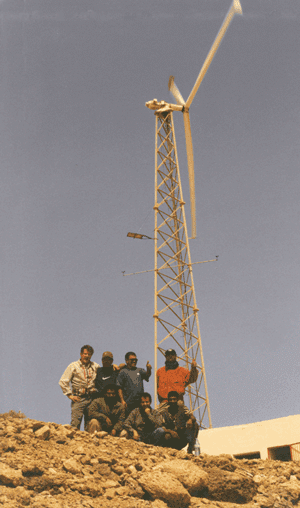 Conceived by Sahara Wind’s founder, an experimental wind test site was installed in 1994 on a desert farm located on the Atlantic coastline. The farm's greenhouse-grown vegetables, tomatoes and melons were originally destined for higher value off-season export markets. These products are currently supplying the region's growing local and regional markets.
Conceived by Sahara Wind’s founder, an experimental wind test site was installed in 1994 on a desert farm located on the Atlantic coastline. The farm's greenhouse-grown vegetables, tomatoes and melons were originally destined for higher value off-season export markets. These products are currently supplying the region's growing local and regional markets.
The facility's electricity needs were supplied by two diesel generators, and a 50 kW wind turbine was added to the system.
The AOC 15/50 wind turbine was connected to a small 5500 volts distribution grid. With a diesel generator providing frequency regulation and backup power, any surplus wind power was fed to a variable-speed driven ice making plant. Used for fish conservation ice has a high market value due to the region’s fishing activities.
 In operation, the AOC 15/50kW wind turbine was among the very first of its category on the continent. It now looks obsolete, as rated powers have increased significantly since. For a hybrid Wind/Diesel system however, the capacity utilized in these wind regimes proved to be more than enough.
In operation, the AOC 15/50kW wind turbine was among the very first of its category on the continent. It now looks obsolete, as rated powers have increased significantly since. For a hybrid Wind/Diesel system however, the capacity utilized in these wind regimes proved to be more than enough.
Wind penetration rates of 70% were averaged with the system running. The control system, never tested outside experimental conditions required several modifications.
To overcome grid stability issues, power electronics and resistive dump loads were gradually added to the system.
To achieve higher efficiency gains, the resistive dump loads -generating essentially wasted heat- can be substituted by electrochemical loads. This opens new perspectives in using the region’s abundant wind resource.
Whereas electrolytic loads enhance access to wind-electricity, co-generated hydrogen, oxygen but also chlorine and caustic are common feedstock used in the processing of minerals available locally.
Besides meeting sustainability and resource maximization criteria, extractive industries can be cleaner and more inclusive.
On-campus deployments of semi-industrial electrolyzer units coupled to wind turbines are currently testing these prospects at partnering universities in Morocco and Mauritania.



